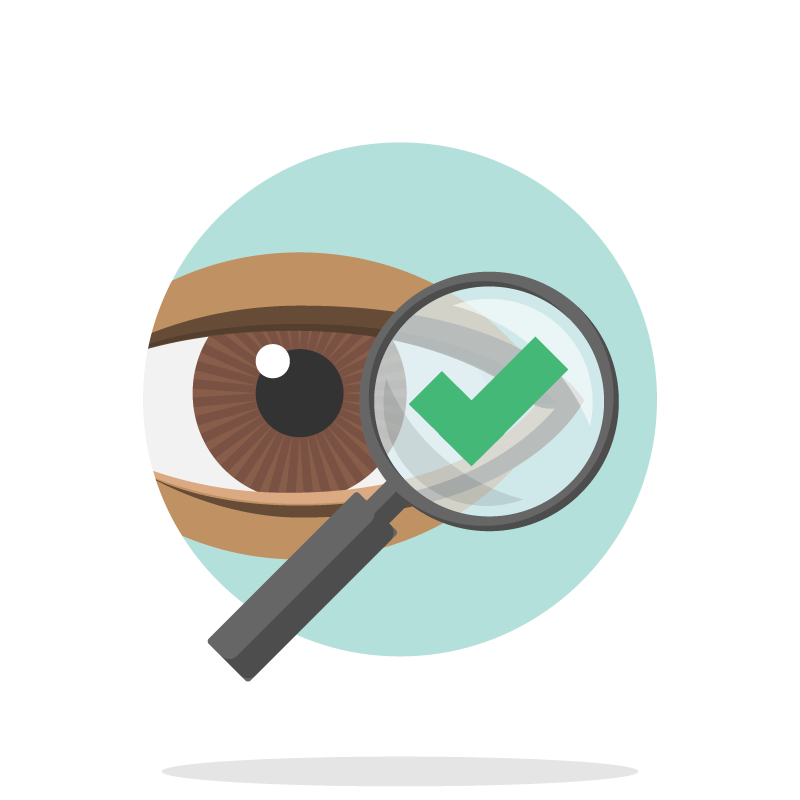QUICK SUMMARY
Why it’s important: Complete eye exams can catch problems early.
Who needs it: Everyone age 40 and over, and anyone else who has eye disease or risk factors for eye problems.
Good to know: Your insurance may cover an eye exam. Check before you go.
What are eye exams?
During a routine eye exam, an eye doctor checks how well you can see at a distance, close up, and at the edges (peripheral vision). A complete eye exam also screens for common eye problems such as glaucoma (high pressure inside the eye).
Why are they important?
Everyone’s eyes change over time. Even if you've never needed glasses or contacts before, you may find you have trouble reading once you hit your 40s. And if you already have glasses or contact lenses, you may need an updated prescription every so often.
Eye diseases also get more common as you get older, and it's best to catch them early. An estimated 17.2 percent of Americans age 40 and older have a cataract — a clouding of the lens in the eye — in one or both eyes. An eye doctor can also offer advice about other common eye problems like refractive errors (nearsightedness, farsightedness, astigmatism, or loss of ability to focus up close), age-related macular degeneration, diabetic retinopathy (which can cause blindness in people with diabetes), glaucoma, amblyopia (“lazy eye”) or strabismus, which causes eyes to cross or turn outward).
Who needs them?
The American Association of Ophthalmologists (they're eye MDs) says that you should have medical eye exams more often as you get older. If you have no signs or risk factors for eye problems, they recommend:
- A baseline exam at age 40. Your ophthalmologist should then tell you how often to have your eyes checked in the future.
- An exam every one to two years if you are age 65 and older.
- Depending on your vision, eye health, and other health conditions like diabetes, you might need checkups starting at an earlier age.
What to expect
Bring your glasses and contact lenses (if you wear them), think of any questions you want to ask and be ready to discuss your family history. Before your exam begins, your eye doctor will ask about your overall health and any vision trouble. Next, you’ll go through several different tests.
- To check overall eye health, your eye doctor may shine a light on your eyes to see how your pupils react or use a slit lamp to look at the fine details of the front of the eye.
- To check your vision, you’ll be asked to read an eye chart. If you have trouble or need a new prescription, your doctor will have you look through a device that tests different lenses to see which one works best for you. If you wear contacts or want to try them, you may wish to ask whether you’ll be charged extra for a contact lens fitting.
- To test your peripheral vision (at the edges of your field of view) you may look into a machine with flashing lights, look straight ahead and tell your doctor when his hand comes into view or stare at an object on a screen and tell your doctor when an object moves into your peripheral vision and when it disappears. Peripheral vision is especially important while driving.
- You might also be checked for color blindness.
- To check for signs of glaucoma, you'll sit at a machine that tests the pressure inside your eyes with a tiny puff of air or sensor that barely touches your eye. Untreated glaucoma can lead to vision loss, so it's important to catch it early.
- For an up-close look inside the eye, you'll have your pupils dilated (widened) with special drops. Your eye doctor will look at your retina (the light-sensitive cells at the back of the eye), optic nerve, and blood vessels.
- Your eyes will be sensitive to light for a while after your dilation, so it's a good idea to wear sunglasses. Consider having someone else drive you home.
Good to know
For adults, simple vision tests and eyeglasses are not always covered by medical insurance. Medical eye exams for glaucoma and other conditions, however, may be covered by some plans, including Medicare Part B. All plans in the Health Insurance Marketplace under the Affordable Care Act must include vision coverage for children. Check your coverage before you go. Optometrists go through four years of optometry school and receive an OD degree (doctor of optometry). They do eye exams, prescribe glasses and contact lenses, and screen for common vision problems.
Ophthalmologists are MDs (medical doctors) who specialize in the eye. They can offer complete medical eye exams, diagnose and treat complex eye problems, prescribe medicines, and perform surgery.
Selected references
Mayo Clinic. Eye Exam. Last updated March 2018.
American Academy of Ophthalmology. Eye Exams and Vision Testing Basics. Last reviewed December 2018.
STAFF
Rally Health





